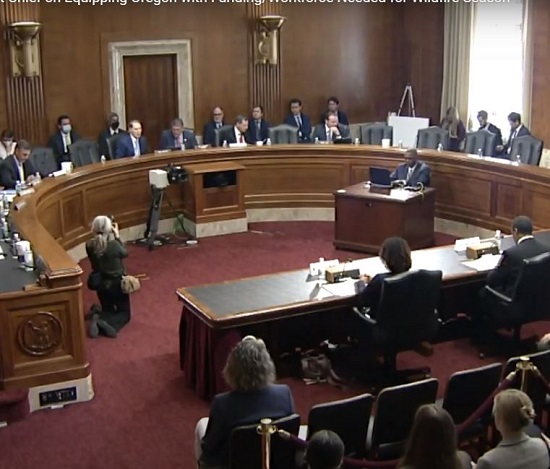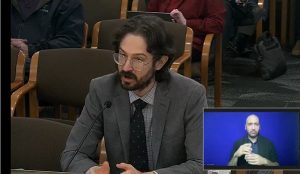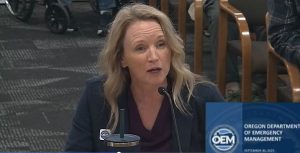With ‘catastrophic’ wildfires expected, Sen. Wyden demands Forest Service take action
4 min read
Washington, D.C. – U.S. Senator Ron Wyden, D-Ore., today pressed U.S. Forest Service Chief Randy Moore on how the agency plans to use the money secured for wildfire in the Bipartisan Infrastructure Law to address the critical shortage of permanent wildland firefighters and make sure Oregon and the entire West are prepared for what is expected to be another catastrophic wildfire season.
His questions to Chief Moore highlighted similar queries in a June 7, 2022 letter to the Biden Administration cabinet members overseeing all federal agencies managing public lands in Oregon.
“As we move into the 2022 fire season, weather data already points to disturbing trends,” Sen. Wyden wrote to Interior Secretary Deb Haaland and Agriculture Secretary Thomas J. Vilsack.
“Oregon remains stuck in severe to exceptional drought conditions across the state. This combined with an apparent state-wide temperature inversion – an anomaly when it persists any longer than a week – all points to yet another dangerous fire season.
“I have heard in years past that agencies needed resources – in terms of funding and workforce – to better position and prepare for the wildfire season. With the passage of the bipartisan Infrastructure Investment and Jobs Act (IIJA) in November 2021, your departments received this much-needed support. Now, more than six months after being given this new flexibility, we are past time for action.
“The Department of the Interior released its 5-year Monitoring, Maintenance and Treatment Plan to Address Wildfire Risk in April 2022 and the U.S. Forest Service released its 10-year Confronting the Wildfire Crisis Strategy in January 2022. While both documents lay out common-sense goals, please provide answers to the following specific implementation questions:
- Please provide an update with specifics on how the wildfire prevention and suppression funds from the IIJA (Infrastructure Investment & Jobs Act) have been allocated and dispersed to the field thus far, including how the funding amounts to each region were determined.
- How many acres in Oregon will be treated using funds authorized by IIJA? Following this and related investments, how many acres will need to be treated to address the hazardous fuels backlog on the landscape?
- How do your departments plan on achieving these strategies when there are 20% vacancy rates for permanent wildland fire positions in Oregon? What plans are in place to fill these positions? What areas of Oregon have been identified as “difficult to recruit” and have any of your agencies used IIJA hiring incentives? If not, will you use those incentives this summer?
- How do you plan on retaining and reforming your workforce structure in light of the ever increasing length of wildfire season – coupled with the increased goals of fuel treatment acres?
- What is the status of the distinct ‘Wildland Firefighter occupational series? When can we expect that to be rolled out so these brave people can be recognized and compensated for putting their lives on the line every summer- instead of being labeled as a Forestry Technician?
- What additional steps have your departments and agencies taken to prevent another season where interagency requests for wildland firefighting crews and engines go unfilled due to insufficient personnel?
- How have your departments and agencies coordinated with local fire departments in Oregon in preparation for the 2022 fire season?
“I look forward to receiving your detailed responses to the above questions in time for Oregonians to prepare for this fire season,” Sen. Wyden wrote. “In addition, I urge your continued efforts to bring wildland firefighters the pay rates, career development, and health care, especially mental health, support they deserve. I also urge increased partnership and coordination with state and local fire response – including local fire departments who often bear the brunt of community coordination when wildfires move into the wildland-urban interface, and an emphasis on effective and efficient fuels treatments near communities and vital natural resources.”
At the Senate Energy and Natural Resources Committee hearing on the Forest Service budget, Wyden also called for better pay and benefits for firefighters.
“Oregonians were telling me last week everywhere I went that the shortage of permanent wildland fire positions, if not addressed, is on its way to becoming a four-alarmer. Already in Oregon there is a 20 percent vacancy rate in these positions and western states are borrowing firefighters from each other. That’s a recipe for trouble,” Wyden said during the hearing.
“What’s the most important response? Better pay and decent benefits for these courageous firefighters so they can pay their rent and buy groceries. That is not the case today according to firefighters talking to me. I was told last week if a firefighter in Oregon has a small family and a modest-sized roof over their head, it takes four paychecks to make a month’s worth of rent.”
Wyden also asked how the Bipartisan Infrastructure Law funding he supported is being used for hazardous fuels treatment and other prevention projects in Oregon and nationwide.
“Millions of acres of dead and dying material is piling up on the forest floor. This material is a magnet for fire. These fires are not your grandfather’s fires — they’re bigger, they’re hotter, they’re more powerful. We’ve got to reduce the backlog [of prevention work],” Wyden said.
Earlier this week, Wyden sent a letter to Interior Secretary Deb Haaland and Agriculture Secretary Tom Vilsack on these issues. Chief Moore committed at today’s hearing to Wyden to help get a timely response to the letter.






